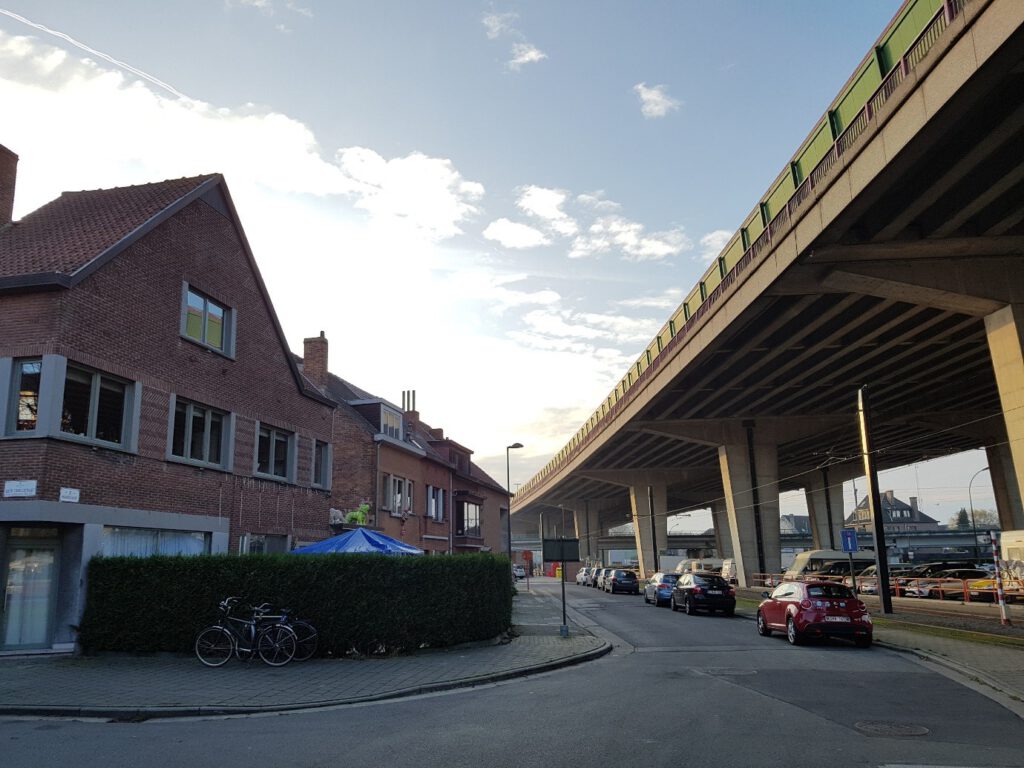Dr Thomas Verbeek, Department of Sociology, University of Warwick
Air pollution is an increasingly urgent matter of public concern in cities and regions around the world. Air pollution was linked to 9 million deaths around the world in 2015, with 92% of deaths occurring in low- and middle-income countries. While poorer countries are the worst affected, air pollution is also a major health problem for countries in the global North. In the UK, where I have recently joined the European Research Council-funded Toxic Expertise postdoctoral research team, 44 cities and towns are breaching WHO air quality guidelines.
One of the major contributors to air pollution in cities is transportation. My doctoral research in Ghent, Belgium focused on the environmental impacts of our transportation infrastructure. In comparison with the impacts of petrochemical pollution that we are studying for Toxic Expertise, these impacts appear less extreme or symbolic. However, because of the scale of the transportation network and the amount of people being affected, the increased pollution levels can also have significant effects at population level, especially in the long term with prolonged exposure. In that sense it can be seen as a form of “slow violence” as defined by Nixon (2011): “a violence that occurs gradually and out of sight, a violence of delayed destruction dispersed across time and space”.
…slow violence is a… violence that occurs gradually and out of sight, a violence of delayed destruction dispersed across time and space”.
What adds complexity is that it is generally difficult to determine who is to blame for the situation, since it is not the road, railway or airport in itself that causes the pollution but everyone who uses it, which is almost all of us – to different degrees. However, in general, the government is in charge of transportation infrastructure. In these environmental conflicts, citizens are thus opposed to the government, in contrast with cases of toxic pollution caused by industries, where citizens are opposed to major companies. Still, the struggles of citizens are comparable in both cases and the aspect of expertise plays a similar role. This will become clear when we address the topic in more detail.
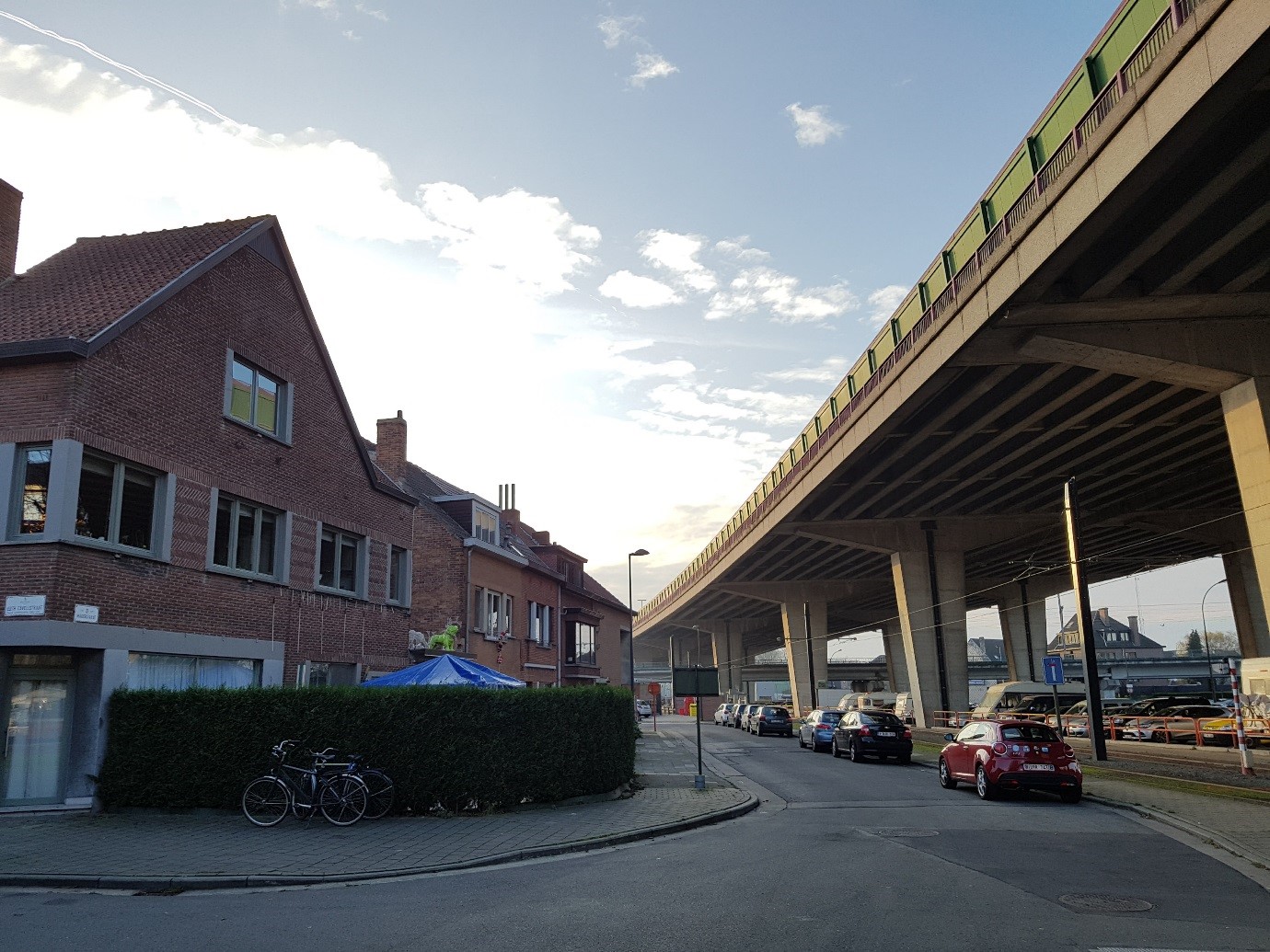
Figure 1. Highway viaduct cutting through a residential neighbourhood in Ghent, Belgium.
When we are talking about the environmental impacts of our transportation infrastructure often also traffic noise is considered next to air pollution. In Europe, it is the second largest environmental impact in terms of annual burden of disease, with at least one million healthy life years lost every year in the western part of Europe. In some countries, especially in the European Union, at first glance we seem to have these pollution problems quite under control. Following the EU Environmental Noise Directive 2002/49/EC and the EU Air Quality Directive 2008/50/EC it is obligatory to monitor and model noise and air quality, set up action plans and inform the population. For air pollution even legally enforceable standards exist that should be met, under penalty of fines, putting pressure on governments to implement an effective environmental policy. However, this environmental legislation – also the air pollution standards – might give a false feeling of safety.
There are three main reasons for this. First of all, these standards are the result of a long political process that lags behind progress in scientific knowledge and – more importantly – does not only reflect health concerns. It is primarily due to political concerns that no enforceable noise standards for traffic noise exist. If severe annoyance and public health would be central, some densely populated countries would pay an unbearably high cost to comply with such standards. Secondly, while we have an increasing knowledge about the health effects of environmental impacts, there are still many uncertainties and impacts we cannot grasp or predict. With regard to the impacts of traffic-related air pollution and noise, the harmful effect on health is not contested any longer, but uncertainty about the details of the relationship and the size of the effects remains. This also means that it is impossible to define safe levels of exposure. Thirdly, using generic standards also means that the specific context of local pollution is not taken into account. Some people are more vulnerable than others, or have less means to protect themselves or to choose where to live. These remarks are in line with the criticism of social scientists towards existing expertise and regulatory systems. In their introductory book chapter on “Powerless Science”, Boudia and Jas (2014) refer to various works that show the limits of scientific knowledge in resolving the issues raised by toxicants and the often political nature of decisions and regulations regarding these substances.
These deficiencies are part of a contradiction at a larger scale that also applies to other policy domains: one between a government that is largely institutionalized and follows a command-and-control policy, and a world that is increasingly complex, volatile and unpredictable. Although this contradiction has existed for some time now, it is only quite recently that citizens are becoming aware of it, particularly with regard to the environmental institutional framework. Due to growing education, dissemination of scientific knowledge, higher expectations of the environment and a distrust of the government, environmental protest is rising in many developed countries. At least in Europe, there are several recent cases where awareness on potential environmental health threats has had a big impact on policy and infrastructure projects.
At least in Europe, there are several recent cases where awareness on potential environmental health threats has had a big impact on policy and infrastructure projects.
An emblematic case in my home country Belgium is the completion of the Ring Road around the city of Antwerp. Some ten years ago, when the plans for a combination of tunnels and viaducts were published in the media, the potential adverse health effects of such infrastructural project were widely covered for the first time, with popular contributions of environmental health researchers. This marked the beginning of years of struggle over the project (Wolf & Van Dooren, 2017). The prospect of potential harm to public health raised awareness and empowerment among citizens. They started to organize, collect information, set up measurement campaigns, consult experts and design alternative solutions. An important pressure group that emerged was the citizen initiative Ademloos (in English: Breathless), which focused on collecting state-of-the-art scientific evidence and disseminating it to the public in an understandable and appealing way. They cooperated with Straten-Generaal (in English: States General for Streets), another community action group which was fighting the project by conducting studies and resorting to legal challenges.
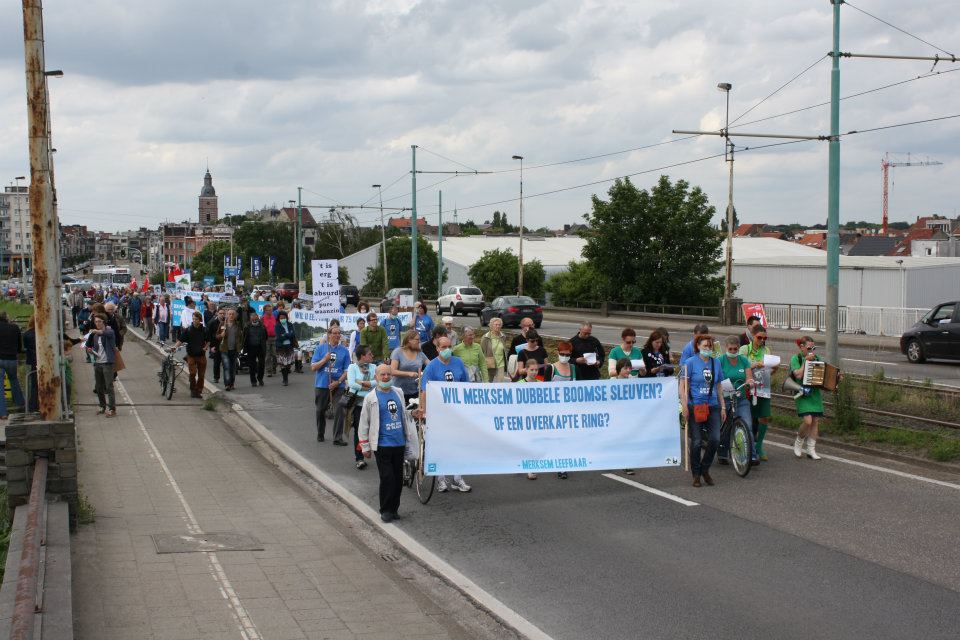
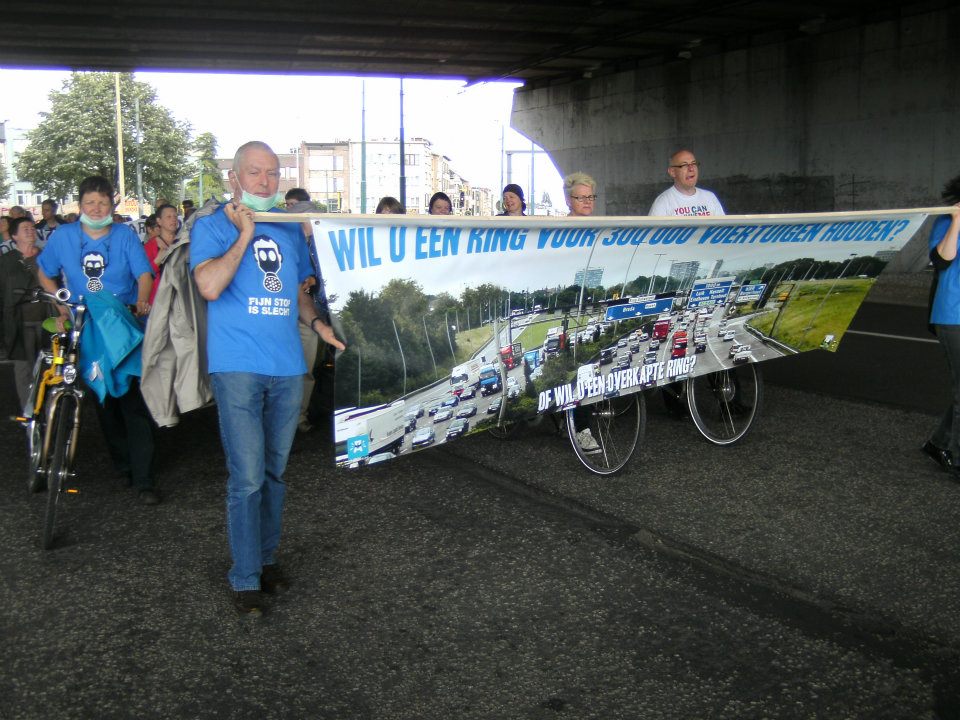
Figure 2 and 3. Protest actions of Ademloos focusing on environmental pollution caused by traffic on the Antwerp Ring Road.
Straten-Generaal stressed the deficiencies in the planning process, which had not involved citizens and had left environmental health concerns to the environmental impact assessment. This assessment process was denounced for its narrow “specialist” view. It relied on norms and procedures that were generic and static, not taking into account the specific context of the project area. By their joint efforts, both groups raised concern about the potential environmental health effects of noise and air pollution and the fairness of the planning process. As such, they could enforce a non-binding referendum in which the project was voted down by a majority of citizens. Another initiative, the Ringland citizen project, was born some years later and developed an alternative plan aiming to convert the existing Ring Road into a tunnel before any new infrastructure was built. This would ensure a better traffic flow, reclaim land for urban use and reduce pollution for thousands of citizens living along the Ring Road. By detailed and clever solutions and a professional campaign they soon gained support of a substantial part of the urban population, again putting pressure on the government to change plans.
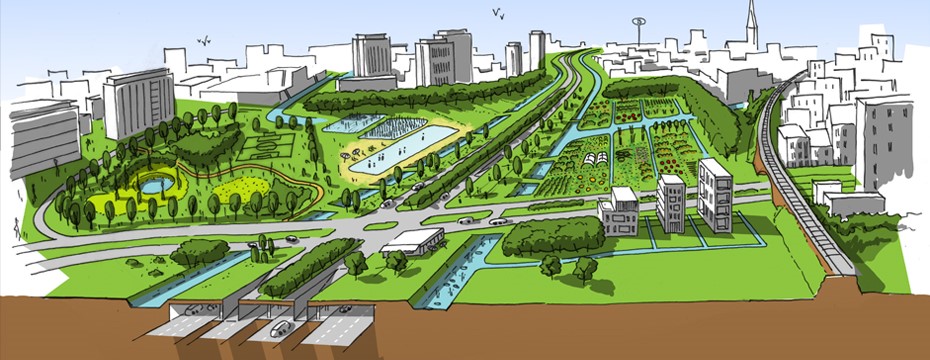
Figure 4. Visionary plans of the Ringland citizen initiative to convert the Antwerp Ring Road into a tunnel, leading to better traffic flow, space for urban development and a reduction of environmental pollution.
However, the government was hesitant and unsure in dealing with this new powerful activism and tried to stick to the policy decisions that were taken. After ten years of discussions and delay, the major stakeholders finally came to an agreement, with the final plan being a combination of the different alternatives. What is most interesting in this case is not the final solution, but how citizens have managed to change the plans of the government because of public health concerns. They did this by not merely sticking to protest actions, but by actively engaging in the discussions, conducting research and devising alternatives. This kind of engagement is very similar to how communities organize to battle the toxic pollution caused by petrochemical industries and fits within the sociology literature on this topic, such as ‘Uneasy Alchemy’ by Barbara Allen. Also in the Antwerp Ring Road case citizens have collected data themselves (“citizen science”); pleaded for recognition of their lay knowledge next to scientific knowledge; and blamed the institutional framework for being too generic and not addressing the situational character of pollution.
Since these conflicts on the environmental impacts of transportation infrastructure generally revolve around a struggle between government and citizens, it seems easier to solve them compared to conflicts where multinational companies are involved. It might sound an appealing idea to just give more power to citizens, to listen to their concerns and ideas and adapt policy accordingly. However, this might be a dangerous option as well.
It might sound an appealing idea to just give more power to citizens, to listen to their concerns and ideas and adapt policy accordingly. However, this might be a dangerous option as well.
I illustrate this clearly in a case study in my PhD research, focusing on a neighbourhood in Ghent, Belgium, that is (relatively) highly polluted by traffic noise and air pollution, caused by two highway viaducts cutting through it. In recent years both viaducts were at the heart of political debate and the focus of environmental pressure groups, with public health concern being an important driver. The debate has emerged quite spontaneously but the local action group Viadukaduk quickly received the full support of the city council, leading to a united front against the Flemish government, administering the road. In this area I carried out data analysis on environmental inequalities and a survey among residents to gain insight into their perception of the situation and their ideas on the existing citizen initiative.
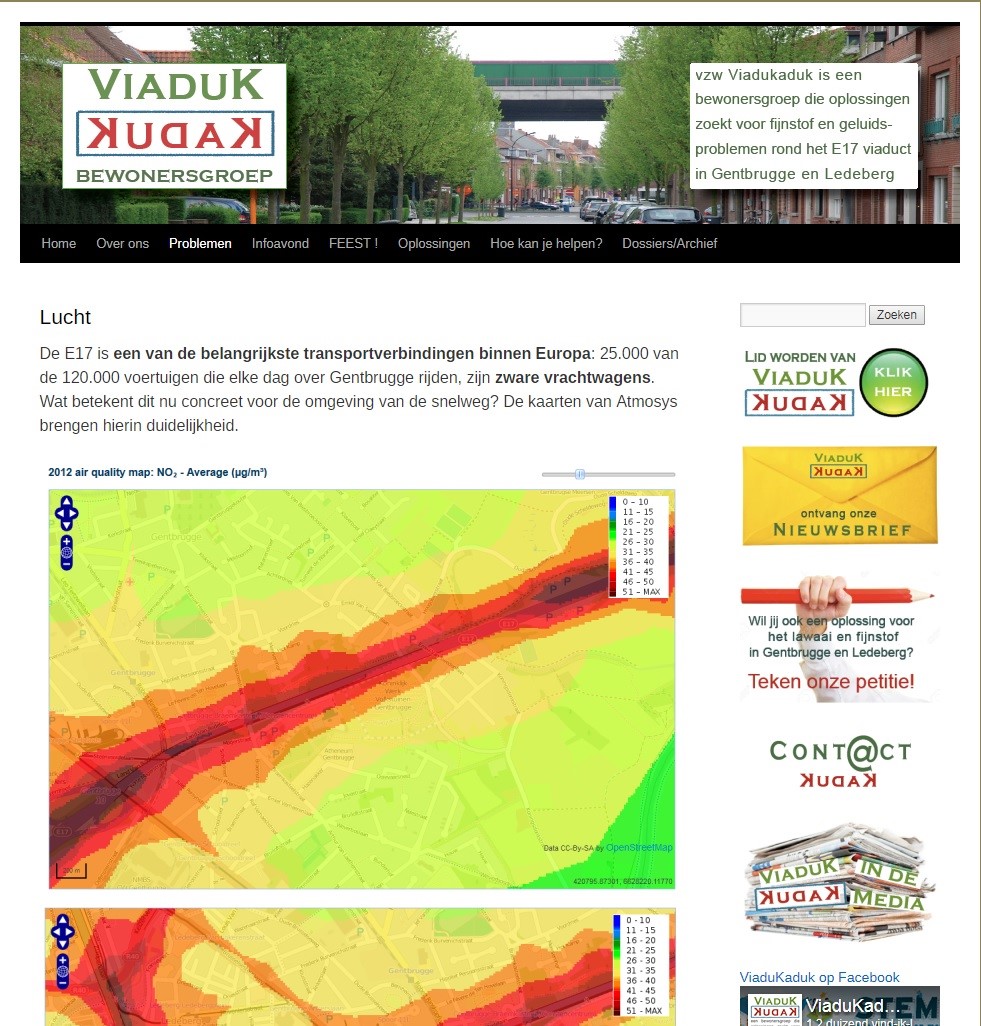
Figure 5: Viadukaduk explaining traffic-related air pollution on its website (in Dutch)
One of the interesting results was that objective and subjective exposure to environmental impacts had a different relation with socio-economic and housing variables. While poorer, less educated people and temporary residents in rented apartments and small houses generally experienced the highest exposures to air pollution and noise according to the models, socio-economically stronger groups and permanent residents owning a (semi-) detached house were generally more annoyed. In addition, the survey showed that it is also this group of people with a higher education, higher income, a full-time job and often owning a (semi-) detached house that rather takes additional protective measures, actively participates in policy and engages in citizen initiatives to raise their concerns. This socio-economically strong and active group is not representative of the whole population, questioning the unequivocal support of the city council for their complaints and initiatives. If a government too blindly adapts its way of addressing environmental health to changing awareness and perception of a certain part of the population, fair outcomes are not necessarily reached.
This does not mean all spontaneous bottom-up initiatives should be counteracted. Their engagement can be very useful in revealing environmental health issues, collecting bottom-up contextual information, raising awareness among citizens and producing novel approaches to (spatial) conflicts. However, we still need a strong government to take up an intermediate role, counterbalancing the local initiative and caring for the equal representation of all citizens. The survey also confirmed that the majority of people do not question the role of the government in these environmental issues, but advocate for additional collaborative approaches. With regard to the case study, the city government could extend the debate, now focusing on the complaints of the protest group, to nearby areas where citizens are less worried (and informed) but environmental problems are at least as severe. At best, we would evolve to a new relation between government and citizens with regard to the environmental impacts of transportation infrastructure, in which both parties are on an equal footing and both scientific and lay knowledge and ideas are taken into account. This would also mean that justice and a “socially acceptable” solution are at the heart of the debate and not science per se, an argument also made by Boudia and Jas (2014).
The survey also confirmed that the majority of people do not question the role of the government in these environmental issues, but advocate for additional collaborative approaches.
A final aspect to touch upon is the crucial role of knowledge and data when we want to achieve a more just decision process with an equal voice for all actors. Because of the complexity of environment and health, it is impossible for planners, policymakers or citizens to have complete information on environmental health effects nor understand all available information. Today environmental justice discussions are often for a large part on the evidence of exposure, on what constitutes reliable information. In the case study in Ghent the citizen movement Viadukaduk does not agree with the methodology of the official noise and air pollution maps, and contests the noise measurements of the Flemish government. The Flemish government in turn does not consider the local subjective concerns and measurements valid. This is in line with the idea of Walker (2010) that gathering evidence should be seen as a claim for knowledge, authority and power, because evidence is always problematic, not a matter of simple fact and truth, but produced through social processes. To avoid discussions about evidence as much as possible and to focus the debate on normative aspects with correctly substantiated claims, a shared knowledge base is needed at project level. It should constantly be updated with available information, both top-down expert knowledge and bottom-up local and subjective knowledge.
Such a collective knowledge base could also change attitudes, raise awareness among planners, policymakers and citizens, and remove the distrust between different actors. At best, a shared knowledge base would banish misinformation and lead to fair and transparent discussions on ethical and normative aspects of policy choices. It would allow the government to take better decisions and citizens to be well-informed participants in planning processes. This recognition of the (questionable) role of expertise and the urge for publicly available and understandable information might be the most important connection between cases on environmental pollution caused by transportation infrastructure and the toxic effects of the petrochemical industry we work on in the “Toxic Expertise” project.
This recognition of the (questionable) role of expertise and the urge for publicly available and understandable information might be the most important connection between cases on environmental pollution caused by transportation infrastructure and the toxic effects of the petrochemical industry we work on in the “Toxic Expertise” project.
(Featured Image credit Hannes Belen)
References:
Allen, B.L., 2003. Uneasy alchemy: citizens and experts in Louisiana’s chemical corridor disputes. MIT Press.
Boudia, S., & Jas, N. (2014). The Greatness and Misery of Science in a Toxic World (Introduction). In Environment in History: International Perspectives (pp. 292): Berghahn Books.
Nixon, R. (2011). Introduction. In Slow Violence and the Environmentalism of the Poor (pp. 1-44): Harvard University Press.
Walker, G. (2010). Environmental justice, impact assessment and the politics of knowledge: The implications of assessing the social distribution of environmental outcomes. Environmental Impact Assessment Review, 30(5), 312-318. doi:http://dx.doi.org/10.1016/j.eiar.2010.04.005
Wolf, E. E. A., & Van Dooren, W. (2017). How policies become contested: a spiral of imagination and evidence in a large infrastructure project. Policy Sciences, 50(3), 449-468. doi:10.1007/s11077-017-9275-3
